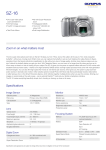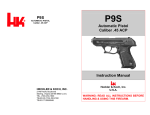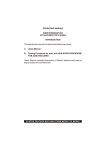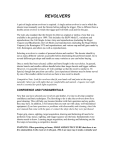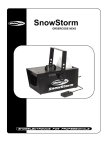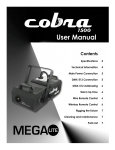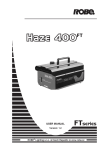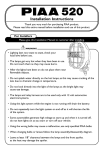Download 18V Cordless Drill User and Safety Manual
Transcript
Model – 22-13800 18V Cordless Drill User and Safety Manual 1 3 1 2 4 5 8 7 6 Operating Controls 1. 2. 3. 4. Keyless chuck Torque control Ventilation slots Rotational direction switch 5. 6. 7. 8. Easy-grip handle Battery pack Battery release Power trigger Tool Specifications Charger voltage / frequency Battery voltage Amperage of battery No-load speed Supported bit range Max torque Charging time 120 V 60 Hz 18 V 2 x 1200 mAh 0 ~500 RPM 0.8~10mm 13 Nm 5~7 hours 2 Intended Use This cordless drill (22-13800) was designed for drilling and fastening into wood, metal, plastic, and some ceramics in consumer and light industrial applications. This tool is not intended for use in masonry or other applications. tool creates heat which may ignite the dust or fumes. Keep children and bystanders away while operating a power tool. Distractions or external influence can cause you to lose control. Safety Precautions Electrical safety The following instructions should serve for the correct and safe use of this tool to avoid damage to the tool and work, and prevent injuries to the user and others. If this tool is to be used by a third party, or passed on, this instruction manual should accompany the tool. Retain this user manual with your tool for future reference. Power tool plugs must match the proper outlet. Never modify the plug in any way. Do not use any adapter plugs with grounded power tools. Unmodified plugs and matching outlets will reduce risk of electric shock. Only plug the charger into a suitable AC power outlet. Ideal charging temperature is between 58°~78°F. Comply with all warning for this tool. The manufacture is not liable for injuries or damage resulting for the incorrect use of this tool. Avoid body contact with grounded surfaces such as pipes, radiators, ranges and refrigerators. There is an increased risk of electric shock if your body is grounded. Be familiar with the controls and the proper use of the tool before attempting to operate it. Know how to quickly stop use in case of an emergency. Do not expose power tools to rain or wet conditions. Water entering a power tool will increase the risk of electric shock and eventual failure. Work area Keep work area clean and well lit. Cluttered and dark areas invite accidents. Do not abuse the cord. Never use the cord for carrying, pulling or unplugging the power tool. Keep cord away from heat, oil, sharp edges or moving parts. Damaged or entangled cords increase the risk of electric shock. Do not operate power tools in the presence of flammable liquids, gases or dust. Power tools create sparks and this 3 When operating a power tool outdoors, use an extension cord suitable for outdoor use. Use of a cord suitable for outdoor use reduces the risk of electric shock. wrench or a key left attached to a rotating or heating part of a power tool may result in personal injury. Do not overreach your work area while using a power tool. Keep proper footing and balance at all times. This enables better control of the power tool in unexpected situations. If operating a power tool on a damp location is unavoidable, use a residual current device (RCD) protected supply. Use of an RCD reduces the risk of electric shock. Do not wear loose clothing or jewelry. Keep your hair, clothing and gloves away from moving parts or heaters. Loose clothes, jewelry or long hair can be caught in moving parts or heaters. Personal safety Stay alert, watch what you are doing and use common sense when operating a power tool. Do not use a power tool while you are tried or under the influence of drugs, alcohol or medication. A moment of inattention while operating power tools may result in serious personal injury or even death. If devices are provided for the connection of dust extraction and collection facilities, ensure these are connected and properly used. Use of these devices can reduce dust related hazards. Use safety equipment. Always wear eye protection. Safety equipment such as dust mask, non-skid safety shoes, hand hat, or hearing protection used whenever conditions require will reduce personal injuries. Power tool use and care Do not force the power tool. Use the correct power tool for your application. The proper power tool will do the job better and safer at the rate of which it was designed. Avoid accidental starting. Ensure the switch is in the off position before plugging in. Do not use the power tool if the switch does not turn it on and off. Any power tool that cannot be controlled with the switch is dangerous and must be repaired or discarded. Carrying power tools with your finger on the switch or plugging in power tools that have the switch on increases the likelihood of accidents. Disconnect the plug from the power source before making any adjustments, changing accessories, or storing power tools. Such preventive safety measures Remove any adjustment key or wrench before turning the power tool on. A 4 reduce the risk of starting the power tool accidentally. Mixing batteries or chargers may result in a fire or battery explosion. Store idle power tools out of the reach children and do not allow persons unfamiliar with the power tool of these instructions to operate the power tool. Power tools are dangerous in the hands of untrained users. When battery is not in use, keep it away from metal and other conductive materials that could short the leads and result in burns or fire. If the battery pack is used in abusive conditions, such as high heat, shock, or moisture, the battery can potentially leak. Avoid contact with the battery; flush skin thoroughly if contact does occur. If the battery liquid contacts eyes or is ingested, consult a medical physician immediately. Maintain power tools. Check for misalignment or sticking of moving parts, breakage of parts and other condition that may affect the power tool’s operation. If damaged, have the power tool repaired before use. Many accidents are caused by poorly maintained power tools. Know your surface that you are drilling before operation. Walls, floors, and ceilings frequently have electrical, gas, water, or other utilities hidden behind them. Be sure to thoroughly check and understand the situation before drilling or fastening. Use the power tool, accessories and tool bits etc., in accordance with these instructions and in the manner intended for the particular type of power tool, taking into account the working conditions and the work to be performed. Use of the power tool for operations different from intended could lead to a hazardous situation. Make sure all parts have finished moving before laying drill down, or holstering it. Avoid frequent stalling when screwing or drilling, as this add additional wear on the battery. Service Have your power tool serviced only by qualified repair person using only identical replacement parts. This will ensure that the safety of the power tool is maintained. Always protect the tool, batteries, and charger from moisture, including excessive humidity. Never leave tool unattended outdoors or leave anything outdoors overnight. Drill specific safety Store tool, charger, and batteries in a cool, dry location, not to exceed 100°F. Use only the batteries and charger which are supplied by the manufacturer. 5 1. 2. Unpacking When unpacking the tool for the first use, make sure that all components are included and undamaged. If any parts are missing or broken, please call your distributor before use. 3. Initial Operation Torque Adjustments The battery is shipped only partially charged. Fully charge the battery for a minimum of 5 hours before its first use. The full capacity of the batter will be established after the first 4~5 charging cycles. 1. 2. 3. 4. 5. 6. Remove the battery pack (6) Open the drill chuck (1) by holding the rear section of the chuck and turn the front section in a clockwise direction Insert the bit firmly into the chuck and tighten by turning the front section while holding the rear section secure. The cordless drill features a step toque adjustment (2) to avoid damage to screws, work surface, and the drill. By turning the torque adjustment knob, you can set the necessary step from 1 (easily turned screws) to 16 (tight, harder to turn screws). Always select the appropriate torque for the work being completed at the time. Remove the battery pack (6) from the tool by pressing the release buttons (7) on either side of the battery and slide tool forward. Slide the battery pack on to the charging base, ensuring that it locks in place. Place the charging base with battery on a secure bench or table near the power supply point. Connect the small plug of the AC adapter into the charging base. Connect the AC adapter to the suitable AC power outlet. Allow unit to fully charge. Variable Speed Control This tool features a variable speed trigger (8) that responds to the amount of pressure applied. For low speed, lightly squeeze the trigger. For maximum speed, fully squeeze the trigger. Changing Rotational Direction By sliding the rotational direction switch (4) to the left or the right of the tool, the bit rotation direction can be changed from clockwise to counter-clockwise. Only switch direction when bit head is not turning. Autolocking Chuck All trade-standard drill and fastening bits up to 10mm diameter can be used with the drill chuck. The tool features a fastaction drill chuck (1) that is used to change drill bits without the use of a chuck key. Maintenance and Storage 6 Before carrying out any maintenance operation, disconnect the battery from the tool. Always keep the tool and ventilation slots clean. They can be wiped with a lightly dampened cloth. Regular cleaning of the appliance will ensure efficiency and prolong the life of the tool. If the tool should fail, despite the rigorous manufacturer’s tests and quality control, the tool can be replaced under a 6 month warranty from date of purchase. Use only original spare parts, batteries, and charges. Store the tool in a cool, dry environment; do not store near flammable or corrosive materials. Never expose the tool to liquids or store in a humid environment. Battery Disposal When batteries have been fully exhausted (average 2 years from original use), dispose of them according to local regulations. 7







